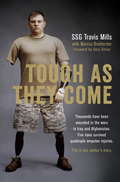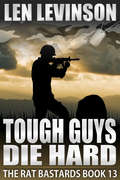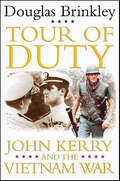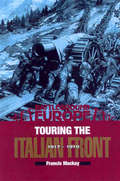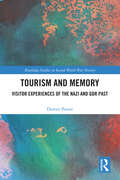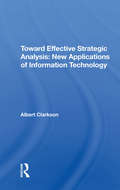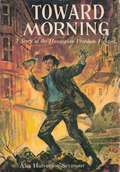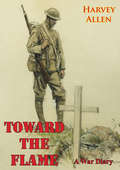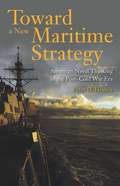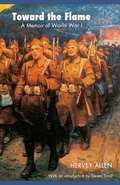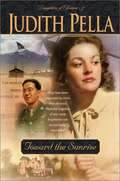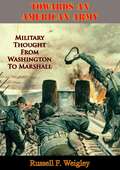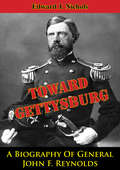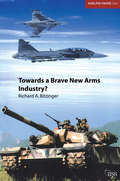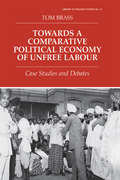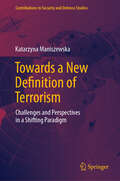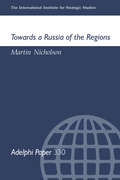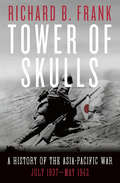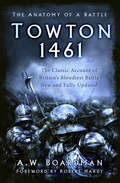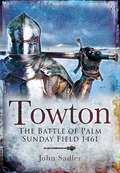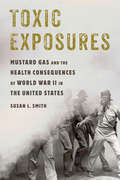- Table View
- List View
Tough As They Come
by Marcus Brotherton Gary Sinise Travis MillsThousands have been wounded in the wars in Iraq and Afghanistan. Five have survived quadruple amputee injuries. This is one soldier's story. Thousands of soldiers die year to defend their country. United States Army Staff Sergeant Travis Mills was sure that he would become another statistic when, during his third tour of duty in Afghanistan, he was caught in an IED blast four days before his twenty-fifth birthday. Against the odds, he lived, but at a severe cost--Travis became one of only five soldiers from the wars in Afghanistan and Iraq to survive a quadruple amputation. Suddenly forced to reconcile with the fact that he no longer had arms or legs, Travis was faced with a future drastically different from the one he had imagined for himself. He would never again be able to lead his squad, stroke his fingers against his wife's cheek, or pick up his infant daughter. Travis struggled through the painful and anxious days of rehabilitation so that he could regain the strength to live his life to the fullest. With enormous willpower and endurance, the unconditional love of his family, and a generous amount of faith, Travis shocked everyone with his remarkable recovery. Even without limbs, he still swims, dances with his wife, rides mountain bikes, and drives his daughter to school. Travis inspires thousands every day with his remarkable journey. He doesn't want to be thought of as wounded. "I'm just a man with scars," he says, "living life to the fullest and best I know how."From the Hardcover edition.
Tough As They Come
by Marcus Brotherton Gary Sinise Travis MillsThousands have been wounded in the wars in Iraq and Afghanistan. Five have survived quadruple amputee injuries. This is one soldier's story. Thousands of soldiers die year to defend their country. United States Army Staff Sergeant Travis Mills was sure that he would become another statistic when, during his third tour of duty in Afghanistan, he was caught in an IED blast four days before his twenty-fifth birthday. Against the odds, he lived, but at a severe cost--Travis became one of only five soldiers from the wars in Afghanistan and Iraq to survive a quadruple amputation. Suddenly forced to reconcile with the fact that he no longer had arms or legs, Travis was faced with a future drastically different from the one he had imagined for himself. He would never again be able to lead his squad, stroke his fingers against his wife's cheek, or pick up his infant daughter. Travis struggled through the painful and anxious days of rehabilitation so that he could regain the strength to live his life to the fullest. With enormous willpower and endurance, the unconditional love of his family, and a generous amount of faith, Travis shocked everyone with his remarkable recovery. Even without limbs, he still swims, dances with his wife, rides mountain bikes, and drives his daughter to school. Travis inspires thousands every day with his remarkable journey. He doesn't want to be thought of as wounded. "I'm just a man with scars," he says, "living life to the fullest and best I know how."From the Hardcover edition.
Tough Choices: A Story of the Vietnam War
by Nancy AntleSamantha finds herself torn by her loyalty to her two brothers, one a soldier recently returned from the war in Vietnam and the other a war protester.
Tough Guys Die Hard: Tough Guys Die Hard (The Rat Bastards Series #13)
by Len LevinsonThe world is their war zone! The war's never over for the battle-toughened Rat Bastards. From one jungle hell to another, they strike raw terror and drive razor-sharp bayonets into the heart of their enemies. Always in the thick of the fight, they hit hard and die harder. And when a new band of misfits joins their ranks, you can hear the panic buttons getting pushed all the way to Tokyo. The Rat Bastards. Turning losers into hell-bent heroes.
Tour Guides at Memorial Sites and Holocaust Museums: Empirical Studies in Europe, Israel, North America and South Africa (Holocaust Education – Historisches Lernen – Menschenrechtsbildung)
by Anja BallisIn this volume, contributors reflect on how to teach and mediate difficult history from the perspectives of guides. Too often, their activities are undervalued and taken for granted. Guides represent an important, often forgotten group of educators. This volume takes a global view on guiding at memorial sites and museums in Europe, North America, and South Africa. The contributors to this volume show from different research traditions that it is worth understanding more about the guides’ personal interests, their motivations, and their concept of guiding. Authors apply methodologies from the social sciences to describe the guides’ point of view. Complementing the various approaches in tour guide research, a detailed linguistic analysis sheds light on a survivor’s testimony echoed in the guides’ language. The studies gathered in this volume open up an orientation for further approaches to tour guiding based on and centered around “authentic” materials from guides.
Tour of Duty: John Kerry and the Vietnam War
by Douglas BrinkleyOne of our most acclaimed historians explores the decorated military service of one of America’s most intriguing politicians—the leading Democratic presidential candidate for 2004—and its profound effects on his career and lifeIn Tour of Duty, Brinkley explores Senator John Kerry’s career and deftly deals with such explosive issues as U.S. atrocities in Vietnam and the bombing of Cambodia. Using new information acquired from the recently released Nixon tapes, Brinkley reveals how White House aides Charles Colson and H.R. Haldeman tried to discredit Kerry. Refusing to be intimidated, Kerry started running for public office, eventually becoming a U.S. Senator from Massachusetts. Covering more than four decades, this is the first full-scale definitive account of Kerry’s journey from war to peace. In writing this riveting, action-packed narrative, Brinkley has drawn on extensive interviews with virtually everyone who knew Kerry well in Vietnam. Kerry also relegated to Brinkley his letters home from Vietnam and his voluminous “war notes” journals, notebooks, and personal reminiscences written during and shortly after the war. This material was provided without restriction, to be used at Brinkley’s discretion, and has never before been published.
Touring the Italian Front, 1917–1919 (Battleground Europe)
by Francis MackayThe guide describes the ground and operations covered by the British, French and US Expeditionary Forces deployed from France to the area North of Venice between November 1917 and Spring 1919. These Forces supported the Italians after their disastrous defeat at Caporetto and helped stem the Austrian and German onslaught.This is the first guide to the Allied contribution and the Piave Defence line. It also covers the rear areas - supply and repair services, training and recreation, and describes the movement to Italy and subsequent service and care of the 16,000 British and 20,000 French horses and mules. The US contribution has never been adequately described before.
Tourism and Memory: Visitor Experiences of the Nazi and GDR Past (Routledge Studies in Second World War History)
by Doreen PastorThis book considers tourism to memorial sites from a visitor’s point of view, challenging established theories in tourism and memory studies by critically appraising Germany’s often celebrated memory culture. Based on visitor observations and exit interviews, this book examines how domestic and international visitors negotiate their visits to the concentration camp memorials Ravensbrück and Flossenbürg, the House of the Wannsee Conference and the former Stasi prison Bautzen II. It argues that memorial sites are melting pots where family, national and global narratives meet. For German visitors, the visit to memorial sites is a confrontation with Germany's responsibility for the two dictatorships while for international visitors it can be a form of 'seeing is believing'. Ultimately, it is the immediacy of the space that is the most important part of the visit. Rooted in an interdisciplinary approach, this book will be of interest to academics and students in German Studies, Tourism and Heritage Studies, Museum Studies, Public History, and Memory Studies.
Toward Effective Strategic Analysis: New Applications Of Information Technology
by Albert ClarksonExploring the future of strategic analysis, this book identifies problems at the heart of the historical U.S. failure to perform effective strategic analysis, then explains and dramatizes how new applications of information technology can make significant progress possible. Certain specific limitations of human memory, says the author, are major ca
Toward Morning: A Story Of The Hungarian Freedom Fighters
by Alta Halverson SeymourOriginally published in 1961, this book tells the vivid story of 14-year-old Teresa Nagy and her family, as they join the Hungarian Freedom Fighters and live through the terror of the Hungarian Revolution of 1956.The reader is taken on a dramatic journey and relives the dangers and excitement of one family’s flight to the safety of the Austrian border.A gripping read.
Toward The Flame: A War Diary (classic Reprint)
by Hervey AllenChronicles the experiences of the Twenty-Eighth Division in the summer of 1918 through the eyes of Lieutenant Hervey Allen and men, made up primarily of Pennsylvania National Guardsmen, who saw extensive action on the Western Front. The story begins with the 28th marching inland from the French coast and ends with their participation in the disastrous battle for the village of Fismette. Allen was a talented observer, and the men with whom he served emerge as well-rounded characters against the horrific backdrop of the war.
Toward a New Maritime Strategy
by Peter D. HaynesThe book examines the evolution of American naval thinking in the post-Cold War era. It recounts the development of the U. S. Navy’s key strategic documents from the fall of the Berlin Wall in 1989 to the release in 2007 of the U. S. Navy’s maritime strategy, A Cooperative Strategy for 21st Century Seapower. An insightful and penetrating intellectual history, it critically analyzes the Navy’s way of thinking and ideas, and recounts how they interacted with those that govern U. S. strategy to shape the course of U. S. naval strategy in the post-Cold War era. The book explains how the Navy arrived at its current strategic outlook and why it took nearly two decades for the Navy to develop a maritime strategy in an era in which the relative saliency of such should have been more apparent to Navy leaders. The author, a Navy captain, doesn’t shy from taking to task the institution and its leaders for their narrow worldview and failure to understand the virtues and contributions of American sea power, particularly in an era of globalization. It describes the reasons behind the Navy’s late development of a maritime strategy during the post-Cold War era. It recounts the origins and evolution of the Navy’s distinctive way of thinking and ideas about sea power since before the Second World War, particularly how they shaped and were shaped by the Navy’s Cold War experiences. It argues that the Navy’s way of thinking and ideas, and how they interacted those that governed U. S. strategy, bounded and channeled U. S. naval strategy away from a maritime approach as they had during the Cold War. It took an implausible series of events for one to emerge, including a losing war in Iraq--that called into question long-standing assumptions about U. S. strategy, threatened the Navy’s relevance, and brought about a systemically oriented U. S. strategic approach--and the appearance of two maritime-minded Navy leaders. It focuses on the process by which the Navy developed its strategic documents, the process where institutional ideas are assembled, negotiated, and reshaped in light of other influences--i. e. , the direction of U. S. strategy, budgetary constraints, perceived threats, and the competing interests of other domestic and institutional actors--because even though the subject is American naval thinking (and here it must be emphasized that the concept itself is somewhat metaphorical as only people can think), that is how real strategy is made.
Toward the Flame: A Memoir of World War I
by Hervey AllenThis book vividly chronicles the experiences of the Twenty-eighth Division in the summer of 1918. Made up primarily of Pennsylvania National Guardsmen, the Twenty-eighth Division saw extensive action on the Western Front. The story begins with Lieutenant Allen and his men marching inland from the French coast and ends with their participation in the disastrous battle for the village of Fismette.
Toward the Sunrise (Daughters of Fortune #3)
by Judith PellaContinuing the Dramatic DAUGHTERS OF FORTUNE Series-Historical Fiction at Its Best! In the midst of bitter conflict at home and abroad, Toward the Sunrise follows the paths of three sisters caught in the heartbreaking consequences of war and of prejudice. It is the summer of 1942, and on three different continents the daughters of newspaper tycoon Keagan Hayes are caught in chaos--within and without. A world at war and a family in turmoil have thrown the three sisters into physical and emotional traumas that severely test faith and fortitude. In Los Angeles, Jackie’s Japanese-American husband is sent to an internment camp. In the Philippines, Blair is captured by the Japanese and imprisoned. In Russia, Cameron is arrested and forced to leave the country. Can each young woman find strength to endure the hardships inflicted upon her and to maintain confidence that God is indeed writing the pages of all their lives? A Riveting Tale of Love and Loss, Triumph and Tragedy.
Towards An American Army: Military Thought From Washington To Marshall
by Russell F. WeigleyThis book is a history of controversies that have surrounded the growth of the United States Army, controversies that have flared over the inextricably related questions of how to attain maximum military security for the United States and how to form an army that will be appropriate to and not subversive of American democratic society.This book offers some measure of information on the attitudes and thought processes that have been traditional and habitual among American professional soldiers. Especially, it reveals something of their customary approach to issues of military policy where such issues merge with those of national policy in general. And to know something about the customary approach of military men to the broadest issues of military and national policy is also of manifest value to the present.
Towards Gettysburg: A Biography Of General John F. Reynolds
by Edward J. NicholsThe definitive biography of Major-General John F. Reynolds, one of the finest generals to command in the Union ranks during the Civil War. The book follows Reynolds' exploits from childhood through his cadet years at West Point, active service in the Mexican War, and then in the Civil War. Universally respected by the men under his command and even within the Confederate ranks; he fought with skill and courage despite often being handicapped by the Union High Command. His lasting legacy rests on his superlative efforts on the first day of the Battle of Gettysburg, arriving in the nick of time to stall and then halt the Confederate advance at the cost of his life."A model of its kind."--New York Times Book Review
Towards Nuclear Zero (Adelphi series)
by David Cortright Raimo VäyrynenRarely in the atomic age have hopes been raised as high as they are now for genuine progress toward disarmament. The new receptivity reflected in the policy declarations of many governments was sparked by a wave of private initiatives led by former senior policy leaders in many countries. This book examines practical steps for achieving progress toward disarmament, realistically assessing both challenges and opportunities associated with achieving a world without nuclear weapons. The book places the current debate over nuclear abolition in the context of urgent non-proliferation priorities and the need to prevent nuclear weapons from falling into the hands of extremist regimes and terrorists. It examines the reasons why more than two dozen states have given up nuclear programs over the years and distils lessons from the end of the cold war to offer policy recommendations for moving toward lessened global reliance on nuclear weapons. Also included are in-depth analyses of proliferation challenges and disarmament opportunities in North Korea and Iran. The book concludes with a detailed roadmap for moving progressively toward global nuclear zero. It proposes a new international security regime based on shared missile defences, nonweaponized deterrence and greater efforts to enhance transnational cooperation.
Towards a Brave New Arms Industry? (Adelphi series)
by Richard BitzingerIn the post-Cold War era, most countries have been forced to radically reduce their arms industries, and abandoned self-sufficiency in favour of a subordinate role in an increasingly globalized worldwide defence industry. This has significant implications for the future of armaments production, for proliferation, and for arms control.
Towards a Comparative Political Economy of Unfree Labour: Case Studies and Debates
by Tom Brass Dr Tom BrassMany works about agragarian change in the Third World assumes that unfree relations are to be eliminated in the course of capitalist development. This text argues that the incidence of bonded labour is greater than supposed, and that in certain situations rural employers prefer an unfree workforce.
Towards a New Definition of Terrorism: Challenges and Perspectives in a Shifting Paradigm (Contributions to Security and Defence Studies)
by Katarzyna ManiszewskaThis book addresses critical questions in the field of terrorism studies that have long eluded consensus in the international community. It discusses why there is an abundance of definitions of terrorism and, on the other hand, the absence of a standard definition of terrorism reflected at the international level, shedding light on the elusive boundaries for achieving a global consensus. The book's two compelling hypotheses pave the way for a fresh perspective on counterterrorism efforts. Firstly, the need for new legal frameworks that adapt to the evolving nature of terrorism, encompassing state-sponsored terrorism. Secondly, by examining the historical roots of terrorism, this book uncovers patterns that could reshape future counterterrorism strategies. Drawing on interviews with 20 leading experts in terrorism studies from diverse backgrounds and regions, this book provides invaluable insights and ensures a well-rounded examination of the subject. It will appeal to students, scholars, and researchers of security studies, political science, international relations, and terrorism studies in particular, as well as policy-makers interested in exploring the complexities of countering terrorism in our ever-changing world.
Towards a Russia of the Regions (Adelphi series)
by Martin NicholsonRussia's state system has changed significantly since 1991, but the question of how the country should be governed has not been answered. Russia's constitutional framework is weak and inherently flawed, and the balance of political and economic power between the centre and the regions is ill-defined. In the absence of a firm constitutional settlement, regional elites have consolidated power, restricting the growth of local democracy and frustrating attempts at graass-roots economic reform. This book argues that establishing an effective and regulated relationship between the centre and the regions requires greater decentralisation, but devolution need not threaten Russia's integrity if it is transparent and based on a greater respect for the rule of law.
Tower of Skulls: From The Marco Polo Bridge Incident To The Fall Of Corregidor, July 1937-may 1942
by Richard B. FrankAn eye-opening, pathbreaking account of the onset of the Asia-Pacific War, by the acclaimed author of Downfall and Guadalcanal. In 1937, the swath of the globe east from India to the Pacific Ocean enclosed half the world’s population, all save a fraction enduring under some form of colonialism. Japan’s onslaught into China that year unleashed a tidal wave of events that fundamentally transformed this region and killed about twenty-five million people. From just two nation states with real sovereignty, Thailand and Japan, and two with compromised sovereignty, China and Mongolia, the region today encompasses at least nineteen major sovereign nations. This extraordinary World War II narrative vividly describes in exquisite detail the battles across this entire region and links those struggles on many levels with their profound twenty-first-century legacies. Beginning with China’s long-neglected years of heroic, costly resistance, Tower of Skulls explodes outward to campaigns including Singapore, the Philippines, the Netherlands East Indies, India, and Burma, as well as across the Pacific to Pearl Harbor. These pages cast penetrating light on how struggles in Europe and Asia merged into a tightly entwined global war. They feature not just battles, but also the sweeping political, economic, and social effects of the war, and are graced with a rich tapestry of individual characters from top-tier political and military figures down to ordinary servicemen, as well as the accounts of civilians of all races and ages. In this first volume of a trilogy, award-winning historian Richard B. Frank draws on rich archival research and recently discovered documentary evidence to tell an epic story that gave birth to the world we live in now.
Towton 1461: The Anatomy of a Battle
by Robert Hardy A. W. Boardman‘Towton, the bloodbath that changed the course of our history . . . an invaluable book.’ - A.A. Gill, The Sunday Times Magazine.‘Boardman has unrivalled knowledge of the ground and the record, such as it is, of the battle fought there.’ - Times Higher Education Supplement.‘an admirably comprehensive account’ - Yorkshire Post.‘a marvel of evocation.’ - Robert Hardy.Palm Sunday 1461 was the date of a ruthless and bitterly contested battle fought by two massive armies on an exposed Yorkshire plateau for the prize of the Crown of England. This singular engagement of the Wars of the Roses has acquired the auspicious title of the longest, biggest and bloodiest battle ever fought on British soil. The slaughter left an indelible mark on the population that has been largely forgotten until relatively recent times: Shakespeare likened the struggle to the wind and tide of a mighty sea that set father against son and son against father. But what drove the contending armies of York and Lancaster to fight at Towton? And what is the truth behind the legends about this terrible battle where contemporaries record rivers ran red with blood?A.W. Boardman answers these questions and many more in this new and fully updated fourth edition of his classic account of Towton. Illustrated throughout with contemporary artwork, modern photographs and specially drawn maps, Towton 1461: The Anatomy of a Battle is a fascinating insight into the reality of the battlefield and the men who fought there in a blinding snowstorm over half a millennium ago.
Towton: The Battle of Palm Sunday Field
by John SadlerThe battle at Towton in Yorkshire on 29 March 1461 was the largest, longest fought and bloodiest day in English medieval history. In terms of the number of troops involved, the ruthlessness of the fighting, the quantity of casualties and the decisive nature of its outcome, Towton stands out from the long sequence of battles fought for control of England in the fifteenth century.This bitter contest of arms was a turning point in the Wars of the Roses and - as a result of the discoveries of modern archaeological research - it is one of the best known. John Sadler, in this vivid reconstruction of the battle, offers a fresh view of a pivotal episode in English history and an unflinching insight into the cruelties of medieval warfare.
Toxic Exposures: Mustard Gas and the Health Consequences of World War II in the United States
by Susan L. SmithMustard gas is typically associated with the horrors of World War I battlefields and trenches, where chemical weapons were responsible for tens of thousands of deaths. Few realize, however, that mustard gas had a resurgence during the Second World War, when its uses and effects were widespread and insidious. Toxic Exposures tells the shocking story of how the United States and its allies intentionally subjected thousands of their own servicemen to poison gas as part of their preparation for chemical warfare. In addition, it reveals the racialized dimension of these mustard gas experiments, as scientists tested whether the effects of toxic exposure might vary between Asian, Hispanic, black, and white Americans. Drawing from once-classified American and Canadian government records, military reports, scientists' papers, and veterans' testimony, historian Susan L. Smith explores not only the human cost of this research, but also the environmental degradation caused by ocean dumping of unwanted mustard gas. As she assesses the poisonous legacy of these chemical warfare experiments, Smith also considers their surprising impact on the origins of chemotherapy as cancer treatment and the development of veterans' rights movements. Toxic Exposures thus traces the scars left when the interests of national security and scientific curiosity battled with medical ethics and human rights.
